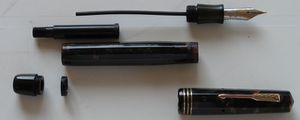Differenze tra le versioni di "Stantuffo tuffante/en"
(Creata pagina con "The principle of operation remains that of all breather tube filling systems, except that in this case the pressure inside the body of the pen is exerted through a hollow pist...") |
(Creata pagina con "Unscrewing the bottom, it is possible to extract the cylindrical piston, which slides tightly with respect to the body of the pen, and to carry out the pumping action through...") |
||
| Riga 5: | Riga 5: | ||
The principle of operation remains that of all breather tube filling systems, except that in this case the pressure inside the body of the pen is exerted through a hollow piston which is accessed from the bottom, which has an extended end part, but perforated at the center so as to be able to flow abundantly around the breather tube, which in this case is very long and comes close to the end of the pen. | The principle of operation remains that of all breather tube filling systems, except that in this case the pressure inside the body of the pen is exerted through a hollow piston which is accessed from the bottom, which has an extended end part, but perforated at the center so as to be able to flow abundantly around the breather tube, which in this case is very long and comes close to the end of the pen. | ||
| − | + | Unscrewing the bottom, it is possible to extract the cylindrical piston, which slides tightly with respect to the body of the pen, and to carry out the pumping action through it. The mechanism is very functional and clearly more advanced than the [[vacumatic filler|vacumatic]] and other similar systems because unlike that it does not require membranes or other flexible rubber elements, and has a greater mechanical simplicity. The disadvantage is the slightly larger size of the mechanism. | |
Nonostante sia fra i più evoluti, efficaci ed interessanti fra i sistemi di caricamento, che presenta tutti i pregi degli altri sistemi a sfiatatoio e nessuno dei problemi legati alla presenza di membrane flessibili in gomma, lo [[stantuffo tuffante]] ha purtroppo avuto una scarsa diffusione, che lo vede limitato nel suo utilizzo alle penne della [[Dunn]] ed al citato modello [[Lucens]] della [[OMAS]].<noinclude> | Nonostante sia fra i più evoluti, efficaci ed interessanti fra i sistemi di caricamento, che presenta tutti i pregi degli altri sistemi a sfiatatoio e nessuno dei problemi legati alla presenza di membrane flessibili in gomma, lo [[stantuffo tuffante]] ha purtroppo avuto una scarsa diffusione, che lo vede limitato nel suo utilizzo alle penne della [[Dunn]] ed al citato modello [[Lucens]] della [[OMAS]].<noinclude> | ||
Versione delle 02:10, 20 set 2019
| Filling systems |
The "stantuffo tuffante" is the name given to the filling system invented and patented by OMAS in 1936 with the introduction of the Lucens model. In reality, a loading system substantially identical to this and equally functional is found on the pens made by Dunn dating back fifteen years. For this reason, even if we cannot establish or not the originality of the invention of the OMAS it is not however correct to assign to it the complete paternity of this type of loading, even if today in Italy we refer to it with the name of "stantuffo tuffante" for the greater notoriety achieved by the Lucens compared to the pens of the Dunn and for the fact that it had not given a specific name to its loading.

The principle of operation remains that of all breather tube filling systems, except that in this case the pressure inside the body of the pen is exerted through a hollow piston which is accessed from the bottom, which has an extended end part, but perforated at the center so as to be able to flow abundantly around the breather tube, which in this case is very long and comes close to the end of the pen.
Unscrewing the bottom, it is possible to extract the cylindrical piston, which slides tightly with respect to the body of the pen, and to carry out the pumping action through it. The mechanism is very functional and clearly more advanced than the vacumatic and other similar systems because unlike that it does not require membranes or other flexible rubber elements, and has a greater mechanical simplicity. The disadvantage is the slightly larger size of the mechanism.
Nonostante sia fra i più evoluti, efficaci ed interessanti fra i sistemi di caricamento, che presenta tutti i pregi degli altri sistemi a sfiatatoio e nessuno dei problemi legati alla presenza di membrane flessibili in gomma, lo stantuffo tuffante ha purtroppo avuto una scarsa diffusione, che lo vede limitato nel suo utilizzo alle penne della Dunn ed al citato modello Lucens della OMAS.
Brevetti correlati
- Brevetto n° US-1351575, del 1920-08-31, richiesto il 1917-06-11, di Charles R. Keeran, Wahl Eversharp. Caricamento tipo stantuffo tuffante.
- Brevetto n° US-1359880, del 1920-11-23, richiesto il 1917-04-07, di Charles Dunn, Dunn. Caricamento tipo stantuffo tuffante.
- Brevetto n° GB-435482, del 1935-09-23, richiesto il 1934-03-23, di Edward Stephen Sears, Swan. Sistema di caricamento.
- Brevetto n° IT-342950, del 1936-01-01, richiesto il , Officine Meccaniche Armando Simoni. Brevetto caricamento stantuffo tuffante.